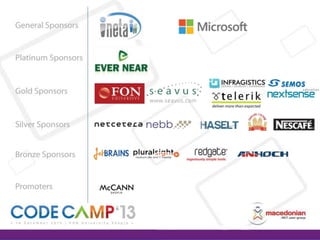SQLCLR Tips & Trics
- 2. SQLCLR TIPS&TRICKS Daniel Joskovski Owner Omnis llc, Principal Developer Daenet, MCT Semos Education joskovski@t-home.mk
- 5. About me
- 6. Agenda ÔÉòWhy SQL CLR? ÔÉòWhat Is Assembly and How To Get Info About? ÔÉòDemo1 ÔÉòCreate CLR Functions ÔÉòDemo 2 ÔÉòDiscussion ÔÉòEncrypt/Decrypt
- 7. Why SQL CLR? ÔÉòA better programming model ÔÉòImproved safety and security ÔÉòAbility to define data types and aggregate functions ÔÉòStreamlined development through a standardized environment ÔÉòPotential for improved performance and scalability
- 8. What Is Assembly Assemblies are DLL files used in an instance of SQL Server to deploy: ÔÉòFunctions ÔÉòStored procedures ÔÉòTriggers ÔÉòUser-defined aggregates ÔÉòUser-defined types
- 9. Getting Info About Assemblies ÔÉò ASSEMBLYPROPERTY('assembly_name', 'property_name')
- 13. Demo 1 ÔÉòGetting Info About Assemblies
- 14. SQL Server In-Process Specific Extensions to ADO.NET ÔÉò SqlContext Object This class provides access to the other extensions by abstracting the context of a caller of a SQL Server routine that executes managed code in-process. ÔÉò SqlPipe Object This class contains routines to send tabular results and messages to the client. ÔÉò SqlDataRecord Object The SqlDataRecord class represents a single row of data, along with its related metadata, and allows stored procedures to return custom result sets to the client.
- 15. • SqlTriggerContext Object This class provides information on the context in which a trigger is run. using System; using System.Data; using System.Data.Sql; using Microsoft.SqlServer.Server; using System.Data.SqlClient; using System.Data.SqlTypes; using System.Xml; using System.Text.RegularExpressions; public class CLRTriggers { public static void DropTableTrigger() { SqlTriggerContext triggContext = SqlContext.TriggerContext; switch(triggContext.TriggerAction) { case TriggerAction.DropTable: SqlContext.Pipe.Send("Table dropped! Here's the EventData:"); SqlContext.Pipe.Send(triggContext.EventData.Value); break; default: SqlContext.Pipe.Send("Something happened! Here's the EventData:"); SqlContext.Pipe.Send(triggContext.EventData.Value); break; } } }
- 16. Returning Custom Result Set Managed stored procedures can send result sets that do not come from a SqlDataReader. The SendResultsStart method, along with SendResultsRow and SendResultsEnd, allows stored procedures to send custom result sets to the client. SendResultsStart takes a SqlDataRecord as an input. It marks the beginning of a result set and uses the record metadata to construct the metadata that describes the result set. It does not send the value of the record with SendResultsStart. All the subsequent rows, sent using SendResultsRow, must match that metadata definition.
- 17. DEMO 2 ÔÉòCreating Managed Objects with Visual Studio
- 18. public static void TransactionHistoryRunningSum() { using (SqlConnection conn = new SqlConnection("context connection=true;")) { SqlCommand comm = new SqlCommand(); comm.Connection = conn; comm.CommandText = @"" + "SELECT TransactionID, ActualCost " + "FROM Production.TransactionHistory " + "ORDER BY TransactionID"; SqlMetaData[] columns = new SqlMetaData[3]; columns[0] = new SqlMetaData("TransactionID", SqlDbType.Int); columns[1] = new SqlMetaData("ActualCost", SqlDbType.Money); columns[2] = new SqlMetaData("RunningTotal", SqlDbType.Money); decimal RunningSum = 0; SqlDataRecord record = new SqlDataRecord(columns); SqlContext.Pipe.SendResultsStart(record); conn.Open(); SqlDataReader reader = comm.ExecuteReader(); while (reader.Read()) { decimal ActualCost = (decimal)reader[1]; RunningSum += ActualCost; record.SetInt32(0, (int)reader[0]); record.SetDecimal(1, ActualCost); record.SetDecimal(2, RunningSum); SqlContext.Pipe.SendResultsRow(record); } SqlContext.Pipe.SendResultsEnd(); } }
- 21. Demo ÔÉòCreating PDF document in SQLCLR using IText
- 22. Documentation used ÔÉò http://msdn.microsoft.com/en-us/library/ms131102.aspx ÔÉò http://msdn.microsoft.com/en-us/library/ms131075.aspx ÔÉò http://msdn.microsoft.com/en-us/library/ms131070.aspx
- 23. • Complete electronic evaluation forms on the computers in the hall and enter to win! – Infragistics Ultimate – Telerik DevCraft – JetBrains .NET tools – Semos training vouchers – Pluralsight subscriptions – and many more…


















![public static void TransactionHistoryRunningSum()
{
using (SqlConnection conn = new SqlConnection("context connection=true;"))
{
SqlCommand comm = new SqlCommand();
comm.Connection = conn;
comm.CommandText = @"" +
"SELECT TransactionID, ActualCost " +
"FROM Production.TransactionHistory " +
"ORDER BY TransactionID";
SqlMetaData[] columns = new SqlMetaData[3];
columns[0] = new SqlMetaData("TransactionID", SqlDbType.Int);
columns[1] = new SqlMetaData("ActualCost", SqlDbType.Money);
columns[2] = new SqlMetaData("RunningTotal", SqlDbType.Money);
decimal RunningSum = 0;
SqlDataRecord record = new SqlDataRecord(columns);
SqlContext.Pipe.SendResultsStart(record);
conn.Open();
SqlDataReader reader = comm.ExecuteReader();
while (reader.Read())
{
decimal ActualCost = (decimal)reader[1];
RunningSum += ActualCost;
record.SetInt32(0, (int)reader[0]);
record.SetDecimal(1, ActualCost);
record.SetDecimal(2, RunningSum);
SqlContext.Pipe.SendResultsRow(record);
}
SqlContext.Pipe.SendResultsEnd();
}
}](https://image.slidesharecdn.com/djsqlclrtips-140118184846-phpapp01/85/SQLCLR-Tips-Trics-18-320.jpg)





